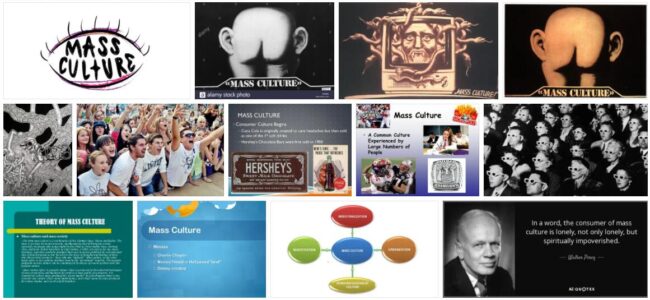The industry, with its technological content, started to dictate the standard of rationality and consumption. It can be said that, with the advent of capitalism in its industrial phase, the culture of society started to have, alongside erudite culture and popular culture , a third dimension: mass culture .
Although the term mass culture is related to the process of human concentration in cities, especially of the popular classes, mass culture cannot be confused with popular culture. After all, while this is, to a large extent, the expression of resistance of the most popular strata to the domain of erudite culture, mass culture is typical of societies that have undergone the commodification of cultural production.
Mass culture is the result of the invasion of industrial products in the universe of culture. It can be said that any symbolic or material expression, such as fashion, produced for the consumer market is mass culture. This aims to entertain, to fill the voids of life in the worker’s rest times. In this, there is not necessarily a content of opposition or communication with erudite culture as there was until then in the game between popular culture and the culture of elites.
Jurgen Habermas wrote:
“Mass culture gets its dubious name precisely because it conforms to the distraction and entertainment needs of consumer groups with a relatively low level of education, rather than, conversely, forming the broader audience in a culture intact in its substance ”.
HABERMAS, Jürgen. Structural change in the public sphere . Rio de Janeiro: Tempo Brasileiro, 1984. p. 195.
In this sense, mass culture does not in itself inform the confrontation between elite and popular cultural productions. In fact, it is a combination of the elite culture and the culture of the people, which is oriented towards the production of a cultural expression that can be consumed, in its totality, by both the people and the elite.
Mass culture promotes an interaction of the polished and illustrated culture with the informal and non-instituted culture, with the purpose of provoking the extensive consumption of symbolic goods.
It is in this mischaracterization and dilution that culture can be transformed into an object of trade and economic gains, that is, mass culture cannot be dissociated from the capitalist logic of profit. Mass culture is what can also be called a cultural industry , after all it is produced to be consumed as a product, as a commodity. In this way, it is devoid of the old links between erudite and popular culture, functioning as a kind of cultural blender.
Mass culture and culture for the masses
For some authors, such as Edgar Morin, mass culture, shaped by economic interests, operates in the imposition of symbols and myths that are easy to universalize: it creates recognizable types, but decontextualized and impoverished by homogenization.
Denys Cuche draws attention to the fact that mass culture cannot be understood as a synonym for “mass culture”, but can be considered as “culture for the masses”. It is interesting to note that popular culture is found in the space where producers and disseminators are the popular classes, the people. In a historical context in which the majority of the population is located in the cities, it is possible to perceive that popular culture can be understood as the “culture of the masses”. The “culture for the masses” is one
driven by the economic interest of cultural producers – which of producers have very little, that is, entrepreneurs who exploit the consumption of culture by the masses.
Some manipulation theories claim that the mass media establish values, dictate consumer fashion and actively participate in the construction of a mass culture. Such theories postulate that the population is a kind of amorphous mass on which powers instituted in capitalist logic act without resistance.
However, authors like Umberto Eco disagree with this simplifying view of the subject. For this thinker, as far as reception is concerned, people cannot be considered as merely passive receptacles of manipulation, because, if it were so, there would have been no social transformations that broke with dominant systems in the history of the 20th century. In addition, the ways of reading, assimilating the culture produced industrially, are not the same for everyone who participates in this mass culture.
Today, mass culture is no longer as omnipotent as it was some time ago. Awareness has increased, through the action of NGOs and social movements, of the acceptance of the use of electronic media by alternative groups (community radio, Internet and independent music production). Add to that the changes undergone by the cultural industry itself, as society imposes itself through interactivity, but that does not mean that mass culture is not very active.




